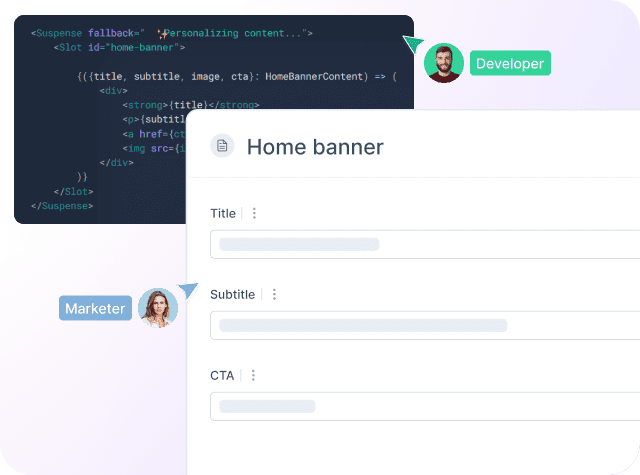Craft CMS has gained popularity for its flexible content management system and developer-friendly approach. Designed for creators and developers alike, it offers a robust platform for building customizable websites with ease.
This article is for teams that use Craft CMS and need better personalization and AB testing. Croct is one of the best alternatives for this challenge since its component CMS can coexist with Craft CMS, which lacks native support for these features. These templates give you a better look at how it works.
If your goal is to build a website that empowers your content team to work independently without needing developers, your key requirements likely are:
- It needs to be fast to load
- It needs to be indexed on search engines
- It needs to be scalable
- It needs to provide a good experience for content managers
But what happens after the website is live?
The marketing team will drive traffic and start analyzing user behavior. Soon, they'll identify optimization opportunities and need to test hypotheses. The next step will be personalizing content for different user segments to boost conversions.
Craft is known for its rich content modeling, ease of use, and modularity. But as the digital landscape shifts toward more personalized user experiences and data-driven decisions, questions arise about whether Craft CMS can keep up with more complex demands like website personalization and AB testing.
Traditional CMS and AB testing platforms are no longer enough. Make your website dynamic to support the growth team's needs.

What Craft CMS is good for
At its core, Craft CMS excels at content management and design flexibility. It allows developers to create custom fields, templates, and structures tailored to specific website needs.
With Craft, you can build anything from simple blogs to complex corporate sites, all without being constrained by rigid templates or clunky page builders. Its control over content and presentation layers makes it a favorite among designers and developers looking for autonomy in their workflows.
The platform also offers a plugin architecture, allowing developers to extend its capabilities with community-driven or custom-built plugins. Whether you need form management, SEO optimization, or even e-commerce, Craft CMS has you covered.
Why Craft CMS isn't ideal for website personalization and AB testing
While Craft CMS is excellent for content management, it falls short in areas that require real-time user interaction and data-driven decisions, such as personalization and AB testing.
Website personalization
Personalizing content based on user behavior, preferences, or other data requires dynamic content delivery that adapts in real time. Craft CMS doesn't provide native solutions for personalization out of the box, which can be limiting when compared to modern CMS platforms with integrated CDP (Customer Data Platform) functionality.
Custom queries in Craft can slow down as you add more data points and complexity, which is a significant concern for websites aiming to deliver personalized content in real time. Many users have reported issues related to slow database queries, which could negatively affect performance, especially under high traffic.
AB testing
While you can use plugins like Optimum to help with AB testing, Craft CMS does not come with built-in support for AB testing, meaning you need external tools or custom solutions to conduct experiments on your site. This can become complex, especially when you want to measure the effectiveness of personalized content.
Craft has basic analytics plugins, but most require integration with external analytics tools like Google Analytics or Optimizely. Without a unified system, setting up tracking, measuring user behavior, and integrating that data into AB tests is cumbersome.
Alternative for personalization and AB testing
These limitations make Craft CMS less ideal for marketing teams, or businesses focused on personalization and data-driven optimization.
If your goal is to create a dynamic website that allows the marketing team to operate independently of developers—or if you'd rather have your developers focus on core product development instead of website optimization—Croct offers a more efficient, powerful solution. Here's why:
-
Gradual integration
Croct seamlessly integrates with any framework, enabling you to fetch dynamic content based on user segments without overhauling your existing infrastructure. It supports both default and static content.
-
Unified solution
Rather than juggling multiple tools for personalization and AB testing, Croct delivers an all-in-one platform that works smoothly with your current CMS. It also comes with built-in CDP and analytics capabilities, saving time and effort.
-
Real-time personalization
Croct makes it easy to segment users by behavior and preferences, serving personalized content in real time. There is no need to build complex logic or custom integrations—Croct handles this automatically.
-
Bayesian AB testing
With native Bayesian AB testing, Croct allows you to run more efficient tests, providing faster, statistically significant results to optimize your website or app with less traffic.
-
Developer-friendly
Croct's intuitive APIs and SDKs simplify personalization and testing workflows, reducing manual effort and making it easier for developers to implement and manage personalization.
If you're curious about how Croct compares with Craft CMS in terms of user satisfaction, this G2 comparison gives you a pretty good overview:
| Ratings | Craft CMS | Croct |
|---|---|---|
| Meets requirements | 8.6 | 9.2 |
| Ease of use | 8.2 | 9.0 |
| Ease of setup | 7.2 | 9.0 |
| Ease of admin | 8.3 | 9.1 |
| Quality of support | 8.2 | 9.8 |
| Good partner in doing business | 9.0 | 9.6 |
| Product going in the right direction | 7.2 | 10.0 |
Why having 3 platforms for content management, AB testing, and personalization when you can have a single one?

But wait, I don't want to switch CMS and rebuild my entire website
No problem—you don’t have to.
Croct is a dynamic CMS designed for experimentation and optimization, so you only need to use it for the elements and components you want to test or personalize.
That means Croct can easily coexist with Craft CMS, where dynamic elements used for personalized communication lives at Croct, while static content remains in Craft CMS.
You can gradually shift components from Craft CMS to Croct, giving your content and growth teams the autonomy they need. Here are some templates to show you how it works.
If your goal is to create dynamic, personalized experiences and boost conversions, take the first step by creating your free account—you can be up and running in just a few hours.